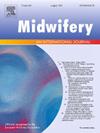Using codesign to support the implementation of a midwifery unit in Europe
IF 2.6
3区 医学
Q1 NURSING
引用次数: 0
Abstract
Background
Midwifery units (MUs) have demonstrated to be a safe and cost-effective model of maternity care. Several European countries do not offer this model yet but are working towards its implementation to improve perinatal outcomes, service users’ and midwives’ satisfaction while making effective use of healthcare resources. Few research projects have focused on the implementation aspect. This study observed and supported the process for implementation of a new MU in Italy using participatory action research (PAR) and codesign.
Methods
A 4-stage project was conducted to codesign an implementation plan aimed at supporting the transition from the obstetrically led maternity unit to an integrated model with a MU. The study engaged maternity professionals, managers and service users via online focus groups and eSurveys.
Findings
Participants identified ten themes to focus the implementation work on: team vision, creation of a multidisciplinary advisory group, creation of a dedicated group of midwives, implementation of intrapartum guidelines for low-risk women, appropriate risk assessment, integration hospital-community, training, effective communication and information for service users and within the team, and reflective practice. Service users supported the initiatives proposed in the implementation plan and expressed openness towards the model of care and its implementation.
Conclusions
This was the first study using codesign and PAR including maternity team, managers and service users to support the implementation of a MU. This work showed value in a collaborative codesign approach. While this work is adapted to the Italian context, the process and findings could be useful in other international contexts.
在欧洲使用协同设计来支持助产单位的实施
助产单位(MUs)已被证明是一种安全和具有成本效益的产妇护理模式。一些欧洲国家还没有提供这种模式,但正在努力实施这种模式,以改善围产期结果、服务使用者和助产士的满意度,同时有效利用保健资源。很少有研究项目侧重于实施方面。本研究通过参与式行动研究(PAR)和协同设计,观察并支持了意大利新MU的实施过程。方法采用4个阶段的项目,共同设计实施方案,以支持产科主导的产科单元向综合产科模式的过渡。这项研究通过在线焦点小组和调查吸引了产妇专业人士、管理人员和服务用户。参与者确定了实施工作的十个重点主题:团队愿景、建立多学科咨询小组、建立专门的助产士小组、实施针对低风险妇女的产内指南、适当的风险评估、医院-社区一体化、培训、服务使用者和团队内部的有效沟通和信息以及反思实践。服务使用者支持实施计划中提出的措施,并对护理模式及其实施持开放态度。结论本研究首次采用协同设计和PAR,包括产妇团队、管理人员和服务用户,以支持MU的实施。这项工作显示了协作协同设计方法的价值。虽然这项工作适用于意大利的情况,但其过程和结果可能对其他国际情况有用。
本文章由计算机程序翻译,如有差异,请以英文原文为准。
求助全文
约1分钟内获得全文
求助全文
来源期刊

Midwifery
医学-护理
CiteScore
4.50
自引率
7.40%
发文量
221
审稿时长
13.4 weeks
期刊介绍:
Midwifery publishes the latest peer reviewed international research to inform the safety, quality, outcomes and experiences of pregnancy, birth and maternity care for childbearing women, their babies and families. The journal’s publications support midwives and maternity care providers to explore and develop their knowledge, skills and attitudes informed by best available evidence.
Midwifery provides an international, interdisciplinary forum for the publication, dissemination and discussion of advances in evidence, controversies and current research, and promotes continuing education through publication of systematic and other scholarly reviews and updates. Midwifery articles cover the cultural, clinical, psycho-social, sociological, epidemiological, education, managerial, workforce, organizational and technological areas of practice in preconception, maternal and infant care.
The journal welcomes the highest quality scholarly research that employs rigorous methodology. Midwifery is a leading international journal in midwifery and maternal health with a current impact factor of 1.861 (© Thomson Reuters Journal Citation Reports 2016) and employs a double-blind peer review process.
 求助内容:
求助内容: 应助结果提醒方式:
应助结果提醒方式:


